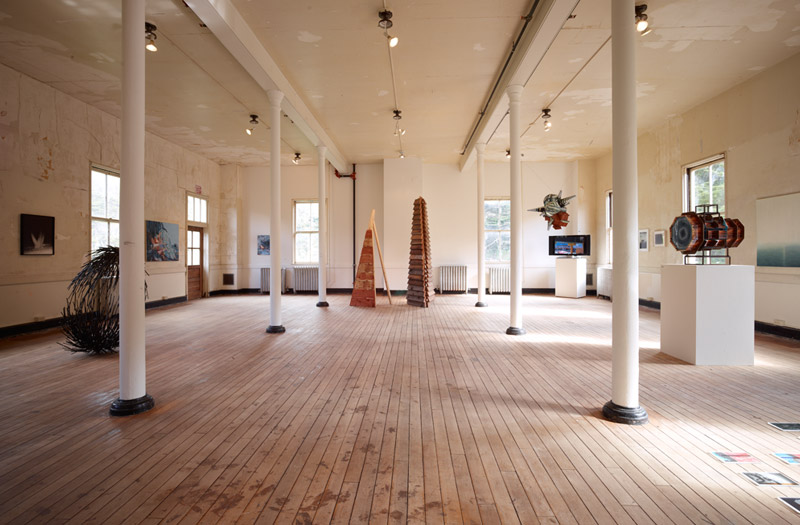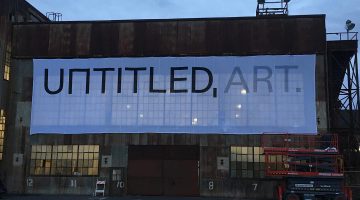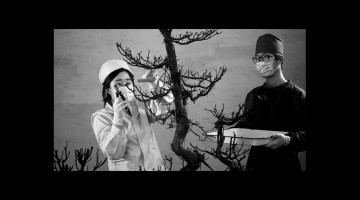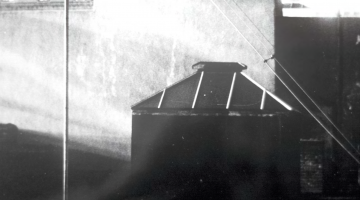Terri Cohn: The residency program at the Headlands Center for the Arts has a commitment to both significant public and private experiences. Can you talk about the founding vision for Headlands?
sharon maidenberg: Headlands was never designed to be a quiet, hermetic, only-for-artists kind of place because it’s on public land, and because the idea from its founding days was to bring people together around cultural exchange and dialogue, creative exploration, and ideas more than products. It was founded to be a haven for artists, but also a place where like-minded community members could get together for discussions, conversations—all different kinds of forums. Some of the spaces were actually designed for that intent with shaker-style seating by David Ireland and Mark Thompson. The idea really was for convivial discourse.
We do struggle with where the line is between public and private experiences. We’re deeply committed to serving artists, protecting them, giving them the space they need without the crazy rat race of the art world. But at the same time I don’t think this was ever intended to be an isolated, ivory tower retreat for artists to escape the real world. The artists that have come here are rooted in the real world, and their work tends to speak to that. We are also interested in making sure that the artists and public are served through the programs here.
Can you talk about that some more?
Headlands is a fairly lean operation and the staff who run it are remarkable. Everyone has got very full plates here. We’re trying very hard to focus on doing what we do really well and not necessarily taking on too many more things. I like to say yes to doing things, and, as an institution, Headlands is very ambitious. I think we’re often coming up against the boundaries of how much we can actually do, as opposed to how much we really want to do.
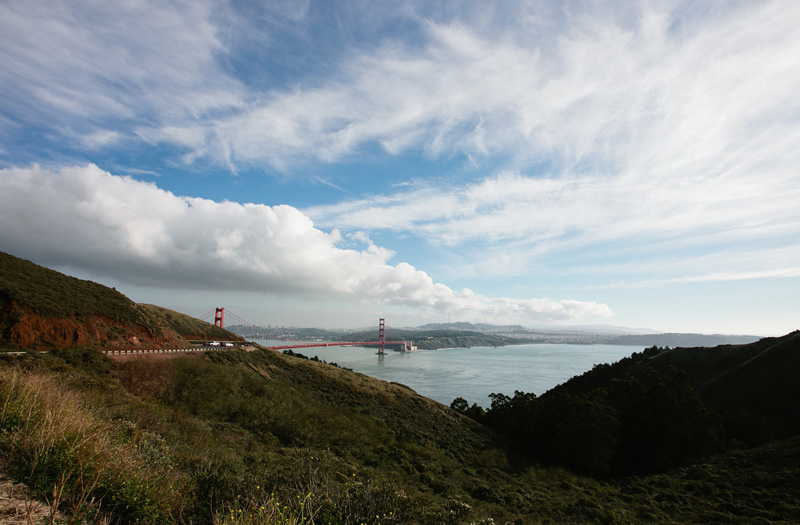
View looking west towards San Francisco from the Marin Headlands.
Perhaps that’s true for every residency program in some regard. I do think you’re welcoming of the greater public, which is more unusual for a residency program.
Right. I wasn’t around when the organization was founded, but I think things change over time, and the needs of the arts community change. There are so many more residency programs now than there were back in the early days. I believe that Headlands’ reputation is top notch and folks think of us as one of the best in the county.
That said, there are many, many more organizations doing this kind of work now. From an internal strategy perspective, we’re always thinking about what niche we fill, what impact we have, whether there’s a need, and currently we’re getting more artist applications than we can manage. There’s always a need from artists for time and space and support and community—all of which we offer. But in the greater scheme of things, I wonder at what point a market gets saturated.
In the nonprofit world, the MO tends to be: “Your goal is to serve the need until there isn’t a need anymore and then you should close up shop.” Historically, that’s kind of the goal of nonprofits, I think. What that need looks like changes over time. Aside from serving artists in the very deep, meaningful ways that we do, I would say that Headlands is deeply committed to being forward thinking. In the Bay Area’s arts landscape we’re seeing smaller organizations really struggle and have to reevaluate who they are, what they do, and how they do business.
Or go away.
I think about that often because I was on staff at New Langton Arts, and it was formative to my professional development. I think a lot about the implications of organizations going away. It’s sad for people who have been deeply involved. Yet, on an existential level, you have to wonder: when do organizations, or the need for them, reach their end? In San Francisco, there remains a need for institutions that support artists. For Headlands in particular, given our location and our facility and the size of the facility, we are doing a lot of deep thinking around how much space we need in order to serve artists, and then what else we can do to serve the community. There aren’t many organizations that have our proximity to the city, our open space, the historic facilities that we have—and want to share with more people—and the kind of thinking going on inside that actually does have a lot of value to share in ways that feel right and good. Bigger organizations can’t do this because they’re focused on the finished product and big shows, which is the role that they fill. We can actually do a deeper dive around process, creativity, artists, and that vulnerable stage where an artist questions: “I’m working on this and I don’t know if it’s going to be any good.”
The recognition that artists need the opportunity to do what they do—whatever that is—is a necessary part of creativity. That’s not necessarily something easy to explain to a funder.
Right. It’s hard for individual funders, and the general public. I have a running joke when I take people on a tour and I’ll often pop into an artist studio and someone will just be sitting at their desk or reading or listening to music. People will ask, “Oh, what are they doing?” I tell them, “They’re working! That’s actually part of the process . . . they’re out walking the trails or in their studio, thinking, looking around.” Making art does not always look like what people envision. I feel there’s a lot of education that can happen here and sometimes, just like anything else, it looks kind of boring from the outside in. I think people have to be willing to rethink what they’re expecting to see. I think it’s also a struggle with things like our Open House, which you know is a big, open-to-the-public, free day. We get somewhere between 500 and 1,000 people out here.
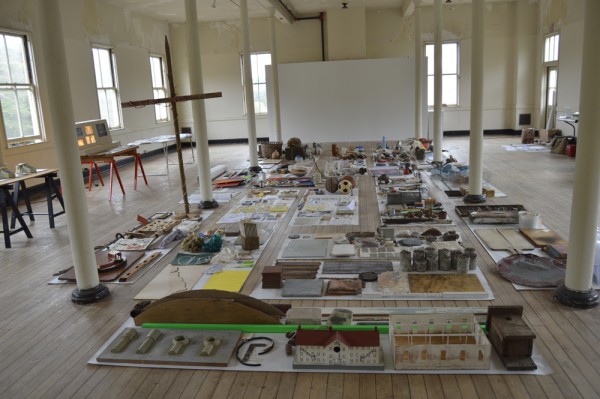
Work by Carrie Hott at Headlands Center for the Arts during a 2014 residency.
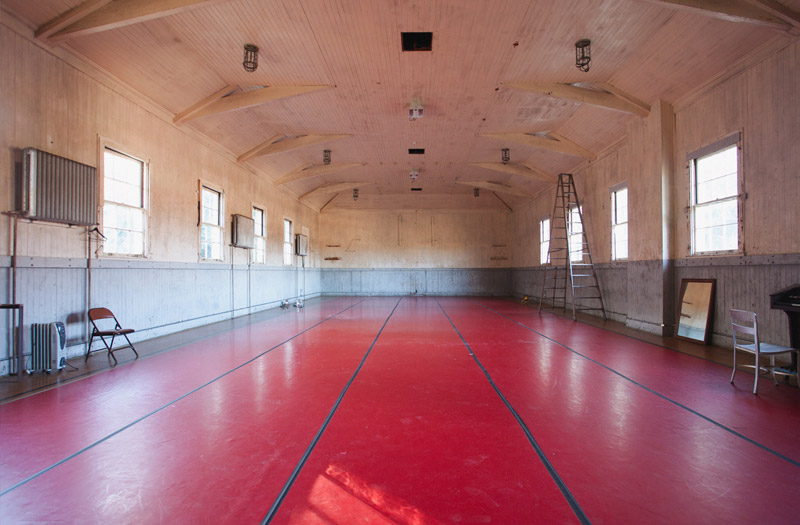
The gym, building 952. Photograph by Andria Lo.
It’s one of my key questions, because different residencies are more or less willing to open up their spaces to the public. Do you feel it puts some burden on the artists? Do the artists have the ability to not participate?
Open House is really the only thing we ask artists to participate in, and we tell artists before they commit to the program what’s expected of them. We find more and more artists interested in looking for opportunities to share their work, whether it’s from a development standpoint—wanting some feedback early on—or they’re looking to network with potential collectors, publishers, or presenters of whatever discipline they’re working in.
I feel like artists are also gaining more understanding about the fact that they are solo businesses, and that they need to be better at talking about their work, at showing their work, at connecting with people. So it’s rare here when someone doesn’t want to participate in an event like Open House. We tend to ask the artists who are open to it, to do more things like Members Dinner, where we offer Headlands members access to a studio visit and then a chance to attend one of our Artists dinners. More often than not, artists are honored to be asked to showcase in that way, which goes against some of the older thinking, that it’s a burden for artists, or we’re kind of impinging on their privacy. Rarely someone will say that they’d rather not participate. We always respect that. But it seems to be that artists more and more are looking for those kinds of opportunities.
It’s interesting; as you’re talking I’m thinking about how social networking media has so changed the world’s relationship to the public and publics.
That’s right. I think sharing now has become very normal and people are giving much more of themselves in this social media way. I think arts organizations across the board are actually looking for that kind of human or personal connectivity. We’ve seen it frequently with bigger organizations. They’re trying to figure out how to offer that direct connection to artists. There is something about connecting people to the human who is making that thing that they might eventually see, or read, or listen to. It makes the work more accessible, whether you actually like it, get it, or not. We work hard to bridge that disconnect between the public and the working process.
There’s also some interesting data in this. I do a lot of looking at reports and data and what people are supporting financially, and in this country people really value the arts, at least on surveys. But the number of people who actually value working artists as a profession is very small relative to those people who value the arts as an entity.
So I think for us there’s a goal of connecting people to artists and also validating artists as professionals and experts in their fields. There’s a long way to go in that respect. I think people tend to still think of the life as an artist as luxurious, you know: “Oh, you get to play in the studio or think up ideas all day long!” This kind of thinking is a big problem because it doesn’t validate the reality that artists are actually professionals.
I’m really struck by something you said, that the relationship between funding and audience engagement is critical in relation to your mission statement: “Headlands Center for the Arts provides an unparalleled environment for the creative process and the development of new work and ideas. Through a range of programs for artists and the public, we offer opportunities for reflection, dialogue, and exchange that build understanding and appreciation for the role of art in society.”
That’s a critical statement—we are trying to connect people to the idea that art is more than just something that someone does quietly in their studio that then shows up in a museum. We really believe in and try to advocate for the idea that artists are thinkers that change the cultural landscape that we live in. An alumni artist once said, “You know, it’s not so much that artists are ahead of the curve; it’s that other people are behind it!” It was thoughtful and spot-on, and it came out very naturally. I replied, “Ah, that’s interesting because part of our work here is to try to connect those ideas and what artists are working on here, and give people access to that so that their thinking changes.” My goal is to have people leave Headlands feeling like they have a slightly different perspective about the world because the art here gave them new insight.
I agree. For the artist, it would be impossible to leave any residency without being changed in some way.
The feedback we get from artists is what keeps me going. There is not a season where the majority of the exit interviews from the artists here don’t talk about how transformative the experience was. I think that’s probably true for most residencies. We like to think that of course Headlands is the best and we do things in a very particular way. We’ve heard, more often than not, that Headlands–for reasons within our control, as well as the variables of the place and its natural environment, the actual campus and accommodations, and the way we’ve set up the program is really special and different than some of the other residencies that people have done.
We open artists up to the freedom to explore, to fail, to mess around with new things. I think it’s a little bit of a misconception to say that we are all about process and not about finished product because at the end of the day most people are here to work on something. So there will be a finished product at some point. We just don’t expect it or require it.
Even if it’s not during their residency here.
Yes, and people aren’t just sitting around thinking and pontificating. Some occasionally do, but I think for the most part most are here working. But I do think it’s a slight shift in perception, because the outside world might think, “Oh, artists just get to go away on these retreats, and they get to hang out, and go for hikes, and have dinner.” It is all of those things and it’s a highly productive time for people.
This is important because after school there aren’t that many formal professional development opportunities for artists—there aren’t many systems and structures in place—especially if artists don’t live somewhere where there’s an active community of art making and There’s something really powerful about the peer-to-peer kind of learning that can happen in a place like this. It’s part of why Headlands is so committed to having a local component to its program.
We are committed to having about a third of our artists in residence be local artists. So each year, of the 45 slots we have to offer, about 15 are for local artists. That’s a huge commitment.
The fact that you have them coming from the major MFA programs in the Bay Area is also really important.
Giving them that year here also creates a cohort of graduates from each of the schools. They come from very different programs, and the year gives them a chance to kind of decompress a little bit from the specific culture of their programs. I think that year is critical for them and whether they commit to staying a professional artist after that, or whether their life takes them somewhere else, I think that gives them an extra little shot at actually staying committed to their work.
It’s important that there are also artists here at different stages in their careers. People genuinely engage without competition, without needing to prove anything. There are upwards of 70 artists here throughout each year, and an amazing community gets formed through that.
I agree . . . I have encountered so many people who were here around the time I was an Affiliate Artist. I did so many projects with visual artists and other writers while I was at Headlands. As you said earlier, it’s interesting how you end up doing things you don’t expect.
Right. When I got here I was convinced that there would be some matchmaking thing we could do, and I realized it’s those serendipitous, connections that happen that are very powerful outcomes for this place.
It’s one of the things artists are best at. Forming relationships is what creative work is about; it’s relationships with materials, with ideas, with other people. The multidisciplinary focus or interdisciplinary focus of artists today draws off of those resources artists naturally have, and are attracted to.
Someone recently said, ”The world has sort of caught up to Headlands.” I think some of the founding values of being cross-disciplinary, being idea-based, and being collaborative were ahead of their time. Now it is very normal for the world to work that way, but I think having those commitments in place very early on positioned Headlands to be the way it is now.
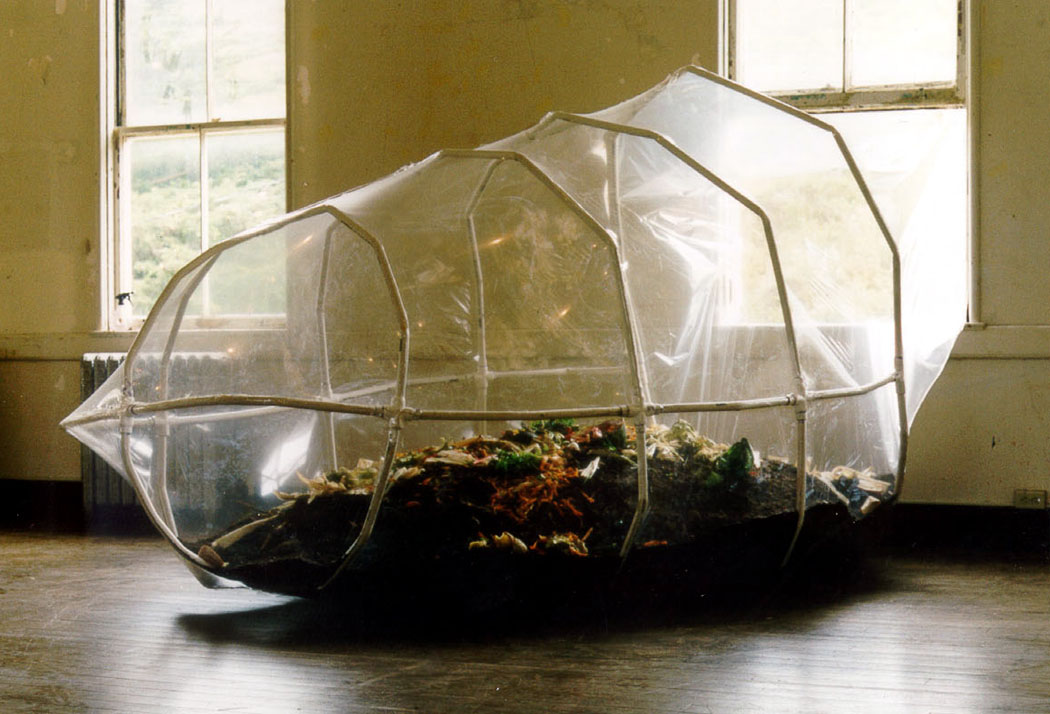
Phil Ross, Composed, 1998. PVC tubing, shrink-wrap, compost, 6 x 5 x 12 feet. Produced at Headlands Center for the Arts during a 1998 residency.
For me, it was challenging because I wasn’t staying on site; I also had young children at the time, which was tricky.
I think it’s a challenge that residencies face–and this was a topic brought up at a recent Alliance of Artist Communities conference. How can we serve women artists with kids, and families in general? It seems like residencies are really good at serving people at particular moments in their life, but there is that phase in your life when you need to spend more time thinking about your family, if you’re going to have one. So we tend to see that the artists who come here are either younger, or past that moment when they have really young kids. We do have what we call family housing, so we can allow, enable, and encourage people with families to not only apply, but also come with their families. We’ve heard mixed reviews. Some people say, “You know, I really just want to come without my family so I can focus.” Some people say, “Being able to bring my family is the only way that I could do this.”
It’s a very individual thing.
We struggle with this a lot, trying to create structures that will support people across the board. Everyone wants something a little different. So in setting up any piece of the program, you quickly learn there is no cookie-cutter solution; that fact makes it really hard to run places like this efficiently. Holly Blake, our residency manager, is an incredible human being who will do whatever she can to make things work for the people who come here.
What’s most challenging about your job?
I think part of our challenge is finding the sweet spot between being incredibly flexible and responsive to the artists, to the community, and to the trends in our field, but also being efficient and running like a business so that our long-term future will be solvent. It’s a really tricky balance. We have no choice but to be incredibly lean as an operation and focused on high return for our financial investment. But we also want to feel like at the end of the day we aren’t sacrificing our program for financial solvency. We’re constantly trying to find ways to keep the program dynamic and relevant and its best possible self, and focus on what our financial models look like.
Have you seen the funding sources change over the last few years?
Pretty dramatically. We decided to shift our focus five years ago to individuals, which is a very tall order. There’s a cap to support from the foundation world and Headlands is lucky to get the kind of foundation support it does . . . Individuals fund about 80% of all nonprofit activity in this country. So we’re looking to people, and that’s part of why we’re thinking about the public’s connection to the place, and the impact of the work that happens here.
At the end of the day people give to things that matter to them. So aside from saying, “Your help goes to support this artist, ”we also have to ask, ”What role do creativity, or artists, or creative thinking play in your life?” I think that’s where our engagement with the public is essential.
So having greater rather than less access is important to that?
Critical. Just making the case in a way that asks questions like, “Do you believe that arts and access to creativity are important to the world that you live in? Do you benefit in some small way from knowing that artists exist and are cared for, and that maybe someday you will engage with the finished product that they are making here?” We’re trying to tie those pieces together.
The idea is that across all of our programs and all of our applicants, we’re picking artists that are the best and the brightest, as well as emerging artists who have tremendous potential, and then seeking funding sources that help support each of them. In an ideal world you have partners who let you do what you do well—and we’re moving more toward that model.
I know Headlands values its alumni, and I wonder how many artists you have served during its 35-year history.
Over the years Headlands has served artists from 48 countries and six continents, a total of more than 1,100 alumni.
I think it’s a really important way to understand the significance of how residencies really serve the creative community.
Absolutely. We think of it as both serving artists by giving them access to a program like this, access to the Bay Area, and various other things. But it’s also giving back to the Bay Area by bringing talent in from around the world and giving local folks a chance to see what this writer from Nairobi or that dancer from Sweden is working on. I’m always shocked at the kind of breadth and the scope of how much we actually do here for such a small institution. I don’t know that that always translates outside. This year we’ve awarded 59 Artists in Residence, and they are joining us from as far as Egypt, New Zealand, Russia, and Taiwan. Included in the group is renowned interdisciplinary and social practice artist Rirkrit Tiravanija, acclaimed writer Mary Gaitskill, New York Review of Books writer and Bidoun Contributing Editor Yasmine El Rashidi, visual artist Leslie Hewitt, filmmaker J.P. Sniadecki, and musician Brian Chase.
What about your relationship with the Golden Gate National Recreation Area (GGNRA)? Do you feel that it has enhanced or impeded things that you’re trying to do?
We would not be who we are if we weren’t here in this incredible place. The fact that we are a partner with the National Park Service is a truly unique aspect of our model; we wouldn’t have this facility if it weren’t for that relationship.
The flip side is that I think the Park—the goals of the Park—are not always 100% aligned with the goals of Headlands, and that’s just the nature of being a partner institution. So their focus on preservation, on the very delicate care of natural and cultural resources, is sometimes a conflict for artists who want to do very ambitious projects. We can’t always allow them to do that.
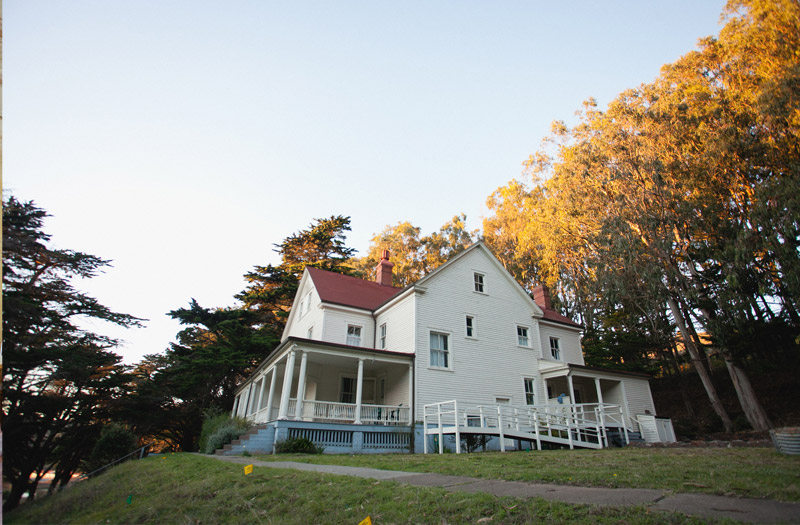
Residence. Photograph by Andira Lo
Because you can’t do it on this land?
You can carefully and delicately, depending on the situation. I think that’s changing somewhat within the Park, although this side of the tunnel is still very concerned with preservation because of the specific habitat. But I still hold onto the fact that Headlands has been presenting contemporary art in the National Park for more than 30 years. We were the first to do it in the Bay Area . . .
Were they concerned about having too many people?
Very much so, and also having art that is too wacky. People have strong feelings about public land. At the same time, the park is also almost 100 years old now. In 2016 it will celebrate its centennial and I think the Park itself is thinking about relevance and audience engagement. So they’re now seeing opportunities to use the arts as a way to get more people to engage with their local Park. The Golden Gate has now surpassed even Yosemite as the most visited Park in the country. They’re seeing a tremendous interest in people coming out, and I think that’s welcome as long as it’s managed carefully.
The other thing that comes to mind is the military presence. Do you think that being in former military quarters enhances or impedes what you do here?
I think that it enhances what we do. It resonates really deeply for the majority of artists, and they come out and have provocative, transformative experiences thinking through the history here, and the fact that this land has now been repurposed from a site that was prepared for war to happen. Many artists make work specific to this place, whether it’s literal—about the military history, the natural environment—or in some way connected to the inherent ideas of the place. For me, that’s a huge part of its identity. There are powerful dichotomies here that resonate with people. This is kind of a tough place, and there is something about that that makes it powerful too.
It makes you consider the different people and groups that have occupied this space. The Native Americans also come to mind.
That’s right. There are different communities who have come through here and left, have either been pushed out or replaced. But I think we try hard to give people a contemporary view of that, both honoring the history but also not requiring a literal response to it. We’re hoping that there’s never an end to how someone might reinterpret this place.
Finally, what would you like to tell people who read this interview?
That’s so hard to answer! I guess the thing that we talk a lot about here is somewhere between bottling the magic and exporting the Headlands experience . . . But I question how much, even in today’s world of social media and web-based activity, you can actually give the experience of being here through digital means. We are really focused on finding that space where we’re not overstepping how much we ask of the artist here. Yet, we are turning much more public in many ways; we are trying to reach many more people and share the Headlands experience and the kind of creativity that happens here. I wonder whether that can happen online or offsite.
As in bringing Headlands to another place as opposed to having them come here?
Exactly. I’m also tracking how much is happening with unplugging, and people trying to get off the grid and things like that. I feel like Headlands was ahead of its time; that’s what we do here. The values and driving principles of this place are timeless. They really resonate right now based on all the things that are happening in the world. People are interested in slowing down, in connectivity, in engagement.
